Q&A – Ask Neil: May 18, 2023
(Please read these instructions carefully.)
Before you post your question, please look at recent issues to see if someone else has already asked it. You might find your answer there.
How to submit your question…
• Click the link provided below to post your question. After you submit your question, a new window will pop up giving you the address to which you can e-mail a sharp, high-resolution photo to accompany your question. Please do not send thumbnail photos in case I need to zoom in to see things.
• Click here to post your question.
• Please only post your question one time. We can only accept a set number of questions each week, and when we get duplicates it costs other people their chances.
• One question per reader, please.
• Please use this only for posting questions – not for standard emails.
• Watch for your answer in the following week’s e-gardens.
• I choose those of greatest general interest. For example, plant IDs seldom make the cut.
• I must have your first name or initials.
• I must have your city or county. (Texas is a very large state.)
QUESTION 1
HOW SOON AFTER PETALS FALL OFF INDIAN BLANKETS CAN I MOW THE PLANTS?
Question: How soon after my Indian blankets’ petals have fallen can I mow the plants? I want to be sure they’ve had time to go to seed for next year. Jan W., Cross Plains.
Answer: Wait until the plants have completely dried – stems, leaves, seeds, and all. It’s better to be a week too late than a week too early. I would cut with the mower at as low a speed as possible. I haven’t done this, but it might make a tidier job if you waited a few days and mowed a second time to pulverize the chaff a bit better.
QUESTION 2
CAN GOLD FLAME HONEYSUCKLE AND OLEANDERS BE SAVED?
Question: I planted Gold Flame honeysuckle and oleanders in our backyard. They looked beautiful and were off to a good start, but then the leaves on both began to turn yellow and fall off. I’ve used Neem oil and nitrogen fertilizer. Can they be saved? Jada D., Rockwall.
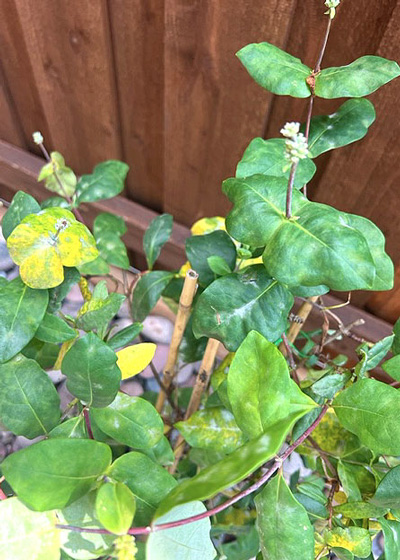
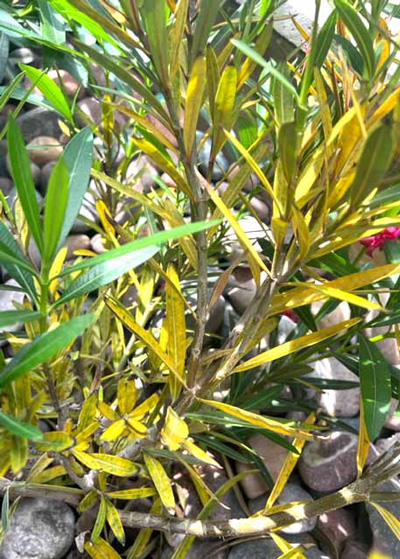
Answer: The Gold Flame honeysuckle looks like it had a bad dose of powdery mildew over the spring. That’s a common problem with it. Fungicides labeled for that disease could probably have helped. I’m not sure what might have caused the yellowing of the oleander leaves, but it looks like the plants may have gotten too dry one or more times. I’m going by the fact that it’s the older leaves that are turning yellow. You might want to trim the plants somewhat and apply a high-nitrogen fertilizer to promote vigorous regrowth. Be mindful of their water needs the rest of this growing season.
QUESTION 3
WHAT IS WRONG WITH MY BELL PEPPERS?
Question: What is wrong with my bell peppers? I’ve sprayed both tops and bottoms of the leaves for what appear to be aphids. I’ve also sprayed the plants with a copper fungicide. The flowers and small peppers are severely compromised. MAC, Tarrant County.
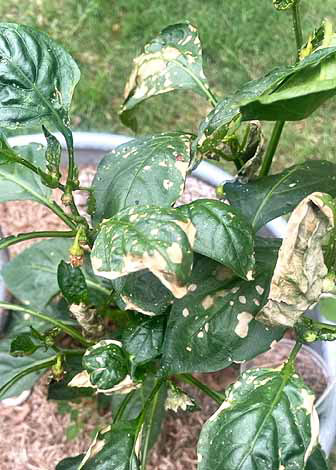
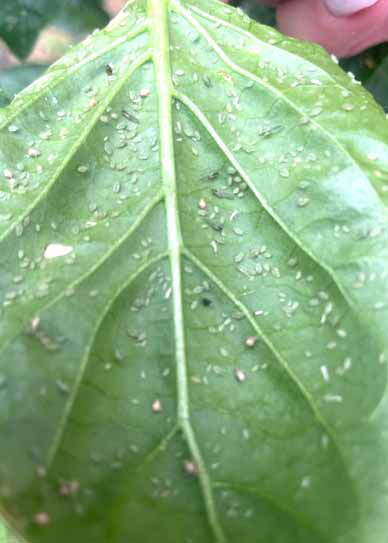
Answer: Your plants certainly are, to use your own word, “compromised.” Perhaps beyond saving. I zoomed in as best I could to see the insects. If they’re pear-shaped, they would be the aphids you suspected, but it appears to me that they’re thrips. Peppers are frequently damaged by them, as evidenced by this blog by a pepper fanatic. I normally don’t refer my readers to non-university sites very often, but his photos and descriptions are good, as are his recommendations. I believe this will be helpful.
QUESTION 4
WHAT IS BEST REMEDY FOR THRIPS?
Question: My roses and vines are being tormented by thrips. I’ve had the best results from weekly Neem drench, but not completely free yet. Betsy F., Kerrville.
Answer: I take my questions in the order in which they are received. How fortuitous you would ask me, since I just did my homework. Please see my reply just above. You didn’t mention what types of vines are being affected, but if they are ornamental vines, you could use a systemic insecticide such as Imidacloprid as a soil drench. Obviously, that cannot be used around edible crops.
QUESTION 5
HOW CAN I KILL THIS VINE?
Question: Is there any way to kill this vine? I have tried everything I can think of. Becky G., Sherman.
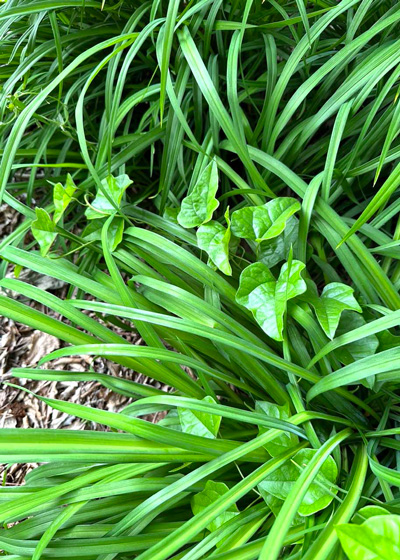
Answer: This is snailseed vine, a common invader in the eastern half of the state. It’s actually attractive when observed growing on an old barbed wire fence in nature, but when it starts to take over a planting of landscape shrubs it’s a different matter. It’s a perennial woody vine that forms a thick root system. If you can get to the crown of its roots you can dig it out fairly quickly when the soil is moist, but otherwise I’ve had the best luck with a roll-type mulch put beneath my shrubs and overlapped by 4 or 5 inches so the vine can’t grow up through the seams. I conceal the roll mulch with finely ground pine bark mulch just for aesthetics, but shredded tree leaves or compost could work just as well.
Here is information on the plant from Texas A&M. As pretty as the fruit is, I don’t think you will want to have the plant in your landscape. The fruit only lasts for a few days before the birds help themselves to it. Before you know it, you’ll have it everywhere.
QUESTION 6
HOW CAN I KILL THIS VINING WEED?
Question: In one area of my flowerbed that is just mulch (no plants) I get this viney weed that grows more quickly than I’m able to pull. Is there any kind of spray that will kill it, or do I just need to dig it up? Jacob M., Plano.

Answer: We’re on a streak. Another vine question. Maybe there will be a week when I’ll have one question asked 10 different times! See my reply directly above.
QUESTION 7
WILL MY SHUMARD RED OAK BOUNCE BACK?
Question: My Shumard red oak is not thriving. It’s been through both of the freezes and the drought last summer as well. Will it bounce back? What can we do to help it? Kim M., Iola.

Answer: You may have seen my admonitions that Shumard red oaks, Chinese pistachios, and red maples must all have their trunks wrapped for the first two or three years after they are planted. Paper tree wrap applied from the ground up to the lowest limbs will protect against sunscald and subsequent borer invasion. I always use the term “non-negotiable.”
That said, I’m not sure that there is damage to your tree’s trunk, but it appears that a crack is developing vertically. Am I looking at the west or southwest side of the tree? If so, there probably is damage there. It’s too late now to wrap the trunk, but I would be careful to keep the tree thoroughly moistened all summer long.
I would be tempted to take 6 to 8 inches of the growing tips off each of the branches now to reduce the pull on the root system. Are those fertilizer granules on the ground beneath the tree? If so, that’s probably way too much, and it could be an additional source of trouble. Remove as much as you can and water very deeply.
QUESTION 8
WHAT CAN WE DO TO HELP OUR LARGE LIVE OAK? ITS OUTER BRANCHES DID NOT LEAF OUT.
Question: What do we need to do about our large live oak? Its outer branches did not leaf out. Shelly S., McKinney.
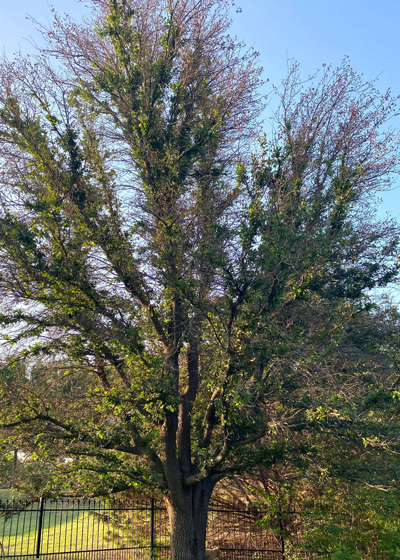
Answer: Our family lives in McKinney, too. As I have been out helping my wife with her school board reelection campaign (successful) the past two months, I have been observing scores of live oaks that look just like yours. This is leftover cold injury from February 2021. Check the bark on the trunk down near the bottom 24 inches. Is it cracking and pulling away from the trunk at all? If not, then the tree will probably heal and get back to work. If there are cracks and splits, if they affect less than 50% of the trunk, then the tree will probably still be fine. Your best bet would be to have a certified arborist work with you to help this tree. Arborilogical Services (our sponsor of e-gardens) does all the work on our trees, and they are outstanding. There are several other very good certified arborists who serve McKinney. Just don’t trust your tree to someone less skilled.
QUESTION 9
WHAT IS THIS STRONG-GROWING PLANT? SHOULD WE KEEP IT?
Question: We found this plant growing in our yard 7 weeks ago. It was 5 inches tall when we replanted it 6 weeks ago, and now it is almost 5 feet tall. Some of its leaves are more than 12 inches long. Should we keep it? Simone C., Weatherford.
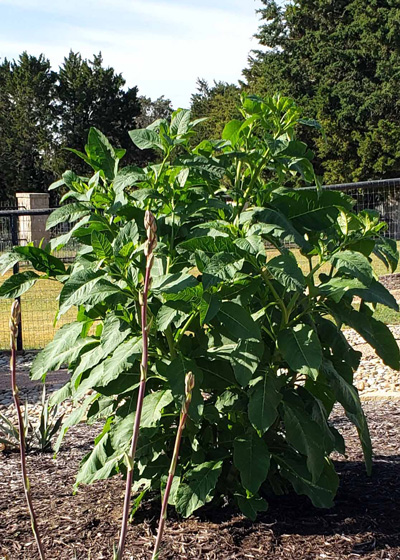
Answer: Looks like poke salad. Lovely plant that the birds savor, but be very careful, as this story suggests. Photos may help you confirm the ID.
QUESTION 10
WHAT IS WRONG WITH MY PEACH TREE?
Question: What is wrong with my peach tree? I’m concerned about the slits and wet-looking spots. Scott B., Parker County.
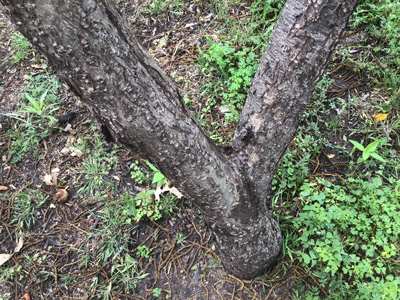
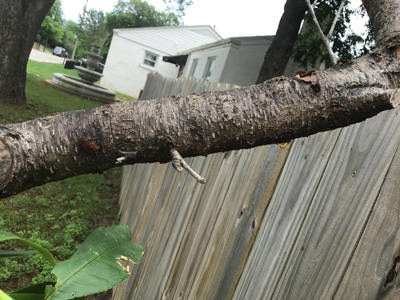
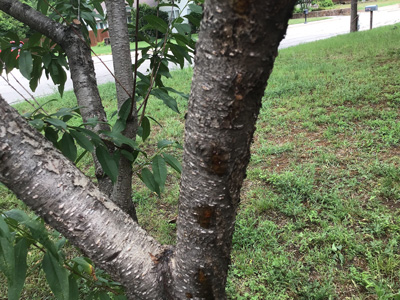
Answer: (Scott called my radio program last weekend. I asked him to send photos to help me understand what he was seeing on his fruit trees. I normally can’t accept photos this way, but since he had waited on hold to speak with me I gave him a way to get them to me and told him I’d answer him here.) Scott, I sent your question and photos to my friend Dr. Larry Stein, Associate Dept. Head for Extension Horticulture and author of The Texas Peach Handbook (TAMU Press). I figured no one would have a better answer. Here were Larry’s thoughts:
“This appears to simply be gummosis where the tree oozes a bit of sap, most often seen in wet years. It could also be lesser peach tree borer, but really does not look like it to me. They can take a knife and cut under the gum and if it is a borer, they will see a work track, if not, then it could be canker. Tree is suffering a bit from the shade, but overall ok, so really don’t think it is bacterial canker.
Keep the tree healthy with water, fertilizer, and mulch. If the tree has not been fertilized, give it 2 cups of ammonium sulfate at the drip line and water in and then mulch the area out to the drip line if they can.”
